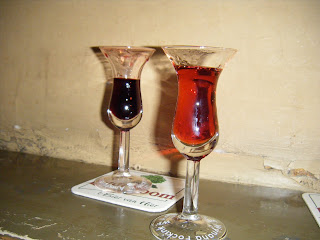Welcome to So It Geuze!
I should probably start by talking a bit about geuze, seeing as I devoted the stupid pun in the title to it. It's the beer I'm currently most obsessed with, and one that is not exactly popular or well-known. If you already know about geuze, tell me what I get wrong, or just don't read SIG till I tell you about my first forays into the world of Brussels geuzes (Moriau, Boon, Drei Fonteinen, Hanssen's in my first week...heh).
Don't worry if you don't like geuze, though, I'll talk about other things here too. Fret not. And if this all seems a bit ... dense, beer-nerdly, stop-talking-and-let-me-drink-g.d. ... come to Brussels and join me for a beer. I promise I don't have to be so verbose in real life.
Geuze is, at its most basic, a blend. A blend of lambics. Of what?
A lambic is, at its most basic, sourdough beer. Well, not dough, but kind of the same. You make beer (101: Take sugar out of grains like wheat and barley, add wonderful things like hops, boil to concentrate and sanitize, add yeast, let sit, yeast eats sugar and "farts" carbonation and "pees" alcohol [excuse the imagery, but I kind of like it], then beer. QED), but for lambic, the yeast is allowed to settle from the air, instead of being added by the brewer. Like pain au levain (sourdough), the funky yeasts from the surrounding area are the lucky ones who get to enjoy your proto-beer.
Like sourdough, lambic is funky. People sometimes use words like «horse-blanket», «mustard», «vinegar», «band-aid», «goats», and «sweat». Not exactly appetizing sounding? Well. You have some drinking to do!
Lambics are often blended - the young ones are a bit
too funky, and need older, mellower ones to relax them. Thus, the Glorious Geuze. Classic geuzes are a blend of 1-, 2-, and 3- year lambics, though any combination really flies, I believe. You never really know - trust the geuze blender (a hard job - imagine trying to tame those flavors!)
Lambics can also be mellowed with fruit: when blended with fresh cherries, you get
kriek. Raspberries give
framboise, peaches
pêche. Some of these are awesome, mouth-puckering experiences that make you see stars like out of a Tintin comic strip. Others are saccharine-sweet and shameful stand-ins for the real thing. Beware the latter, unless you like Smirnoff Ice or caramel macchiati. I won't judge if you buy one, I promise. I just won't have a sip.
A cool thing about lambic, and therefore geuze, is that it really can only come from the Pajottenland / Senne valley area of Belgium, including Brussels and the area just to the southwest. It is only here that the wild yeasts are right. Sure, you can come to Brussels, take a little wood from Cantillon brewery, then leave it in your basement and see how your homebrew turns out, but it won't really be a lambic. Good luck with that experiment, though - I'm curious to hear how it goes. So, aren't you lucky that your boy reporter just happens to be smack dab in the middle of the Senne Valley?
This is enough for now, probably too much. If you can, find yourself a geuze, or something blended, and take a seat, 'cause you'll need it, and pop the cork (they come in champagne bottles, how elegant!) If you don't like it at first, stop drinking. No need to force it. Try again in a couple months - maybe it'll stay on your mind and you'll have to come back to it. They're wily, they're fun, they're refreshing, they're beguiling. Just try.
Till next time ... Moriau Oude Geuze.
«Tintin»
 (mmm, cranberry and raspberry...)
(mmm, cranberry and raspberry...)













